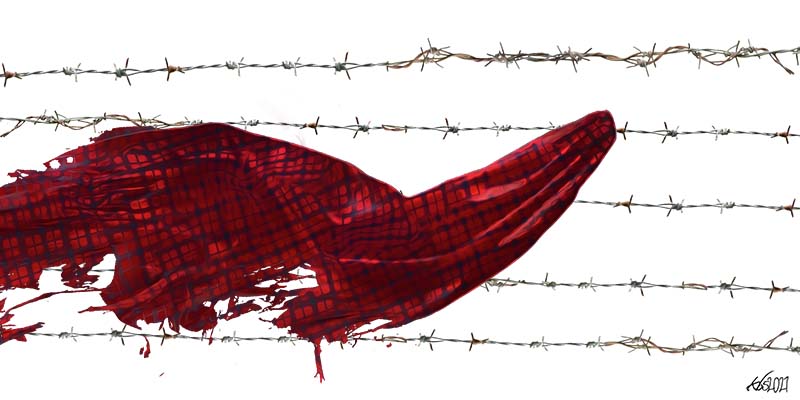“Here we have a territory (now that the Uganda Railway is built) admirably suited for a white man’s country, and I can say this with no thought of injustice to any native race, for the country in question is either utterly uninhabited for miles and miles or at most its inhabitants are wandering hunters who have no settled home . . . .” Sir Harry Johnstone
There have been significant changes in the pattern of land ownership in Laikipia in the last two decades. These changes are set against a background of profound inequalities in land ownership in a county where, according to data in the Ministry of Lands, 40.3 per cent of the land is controlled by 48 individuals or entities. The changes have not brought about an improvement in the lives of the pastoralists and other indigenous communities who occupied Laikipia before colonisation. These groups — and the Maasai in particular, following their 1904 and 1911 treaties with the British — were forced out and relegated to reserves in southern Kenya to make way for the establishment of large commercial ranches owned by White settlers. Those indigenous inhabitants who remained were pushed by subsequent colonial legislation to Mukogodo in the north of the county, the driest part of Laikipia.
The pastoralists did not recover their land with the end of colonial rule. On the contrary, Jomo Kenyatta, the first president of Kenya, encouraged White settlers to remain after independence and today, some of the descendants of those settlers who decided to make Kenya their permanent home still occupy vast swathes of land in Laikipia County. Those who were unwilling to remain in Kenya under majority rule sold their land to the Kenyatta administration. As Catherine Boone, Fibian Lukalo and Sandra Joireman observe in Promised Land: Settlement Schemes in Kenya, 1962 to 2016,
With the approach of independence, the settler state and the British government stepped in to protect the interests of Kenya’s white land-owners by creating a land market for white settlers who wanted to sell their agricultural holdings, and supporting land values for those who wanted to stay. The buyer of most of these properties was the Government of Kenya, using loans provided by the British Government and the World Bank. Through this process, the Kenyan state acquired about half of the land in the (ex-) Scheduled Areas.
In 1968, under the World Bank-funded Kenya Livestock Development Programme — whose stated objective was “to increase beef production for home consumption and export mainly by subsistence pastoral groups” — the government enacted the Land (Group Representative) Act (Cap. 287) that saw the creation of 13 group ranches in the northern part of Laikipia, which is the driest part of the county. However, well-connected local elites helped themselves to part of the land, excised as individual ranches. There are 36 such individual ranches that should have been part of the group ranches.
Those ranches that were sold to the Kenyan government by the departing British settlers are within the expansive Laikipia plateau. The government later sold them to land buying companies formed by Kikuyus that in turn subdivided them into individual holdings. Examples of such lands include Kamnarok, Kimugandura, Kirimukuyu, Mathenge, Ireri and Endana, among others. The remaining land was gazetted as government land such ADC Mutara and Kirimon, or outspans such as Ngarendare and Mukogodo, which were used for finishing livestock for sale to the Kenya Meat Commission.
Land tenure and use
In the Kenyan context, and compared to other counties, the history of land in Laikipia County is unique, with a diversity of tenure systems each representing a unique system of production. The map below shows the different land use and tenure systems in Laikipia County that include large-scale ranches, large-scale farms, group ranches and smallholder farms.
There are 48 large-scale ranches sitting on 40.3 per cent of the total land area in Laikipia County, 9,532.2km², some of which are still owned by the descendants of the colonial settlers. The ranches occupy huge tracts of land, the three largest being Laikipia Nature Conservancy with 107,000 acres, Ol Pejeta with 88,923.79 acres, and Loisaba with 62,092.97 acres.
Source: Ministry of Lands
Most of these large-scale ranches — many of which have an integrated economic system that includes livestock, horticulture, wildlife conservation and tourism — were acquired during the colonial period and legislation governing their ownership was taken from the colonial law and integrated into the constitution of independent Kenya under the land transfer agreement between the colonial government and the Kenyatta regime. It should be noted that the Maasai land campaign of 2004 pushing the government to address historical injustices following the forced ouster of Maasai from their ancestral lands in Laikipia, brought to light the fact that some of these ranches had no legal documents of ownership. In an article titled In the Grip of the Vampire State: Maasai Land Struggles in Kenyan Politics published in the Journal of Eastern African Studies, Parselelo Kantai observes,
Ranchers interviewed could not remember how long their own land-leases were supposed to last, were unaware of the Anglo-Maasai Agreement, and, in at least one case, were unable to produce title deeds to their ranches. And when opinion was expressed, it bordered on the absurd: the ‘invaders’, observed Ms Odile de Weck, who had inherited her father’s 3,600-acre Loldoto Farm, were not genuine — not Maasai at all. They were, she noted emphatically, Kikuyus. The Maasai, she said, had willingly ceded rights to Laikipia, had been compensated long ago and now resided happily in some other part of Kenya, far away.
Immediately following the campaign, the Ministry of Lands started putting out advertisements in the print media inviting those landowners whose leases were expiring to contact it.
Twenty-three large-scale farms occupy 1.48 per cent of the land in Laikipia County. These farms are mostly owned by individuals from the former Central Province who bought the land following sub-division by the Kenyatta administration, or through land buying companies, which opted not to sub-divide the land but to use it as collateral to access bank loans.
Source: Ministry of Lands
Smallholdings sit on 27.21 per cent of the total land area in Laikipia County. These farms were initially large-scale farms bought by groups of individuals who later sub-divided them into smallholdings of between two and five acres. There are three categories of farmers in this group: those who bought land and settled to escape land pressure in their ancestral homes, those who bought the land for speculative purposes, and those who bought land and used it as collateral for bank loans. A majority of the first group still live on their farms, practising subsistence, rain-fed agriculture. Most members of the other two groups are absentee landowners whose idle land has over time been occupied by pastoralists in search of water and pasture for their animals, or by squatters seeking to escape the population pressure in the group ranches. In some cases, pastoralists have bought the idle land and have title.
The 13 group ranches cover 7.45 per cent of the total Laikipia land area and are occupied by pastoralists who use them for communal grazing. However, some of the group ranches such as Il Ngwesi, Kijabe, Lekurruki and Koija have also established wildlife conservancies and built tourist lodges.

Source: CETRAD
Changing land ownership, changing landscapes
Since the late 1990s, when agitation for political reforms and a new constitution began in earnest, and in the intervening period, new patterns of land ownership and land use have been emerging in Laikipia County.
Data from the Laikipia County Government indicates that 16 of the 48 large-scale ranches have been internally sub-divided into units of between 3,000 and 4,000 acres, with the land rates due for each sub-division paid according to the size of the sub-division. The sub-divisions are made through private arrangements and do not appear in the records at the Ministry of Lands. There are claims that the sub-divided parcels have been ceded to European retirees looking to acquire land for holiday homes in Laikipia, and to White Zimbabweans. There are also claims that the large, palatial, private residences that have sprung up within the sub-divided parcels are in fact tourist destinations for a high-end clientele in a business that operates outside Kenya’s tourism regulatory framework and violates Kenya tax laws.
In the Kenyan context, and compared to other counties, the history of land in Laikipia County is unique, with a diversity of tenure systems each representing a unique system of production.
Whatever the case, the County Government of Laikipia confirms, “Most of the white settlers buying property are soldiers or tourists who loved the [county’s] climate, its people and natural beauty and want to experience it all over again. Big time investors [sic] in real estate flock the area, either to buy or construct multi-million shilling holiday homes, targeting wealthy European settlers and tourists.”
The Laikipia County Government also confirms that the large-scale ranches have also been leasing training grounds to the British Army Training Unit Kenya (BATUK), adding, “In 2009 BATUK expanded these grounds to 11 privately owned ranches, including Sosian, Ol Maisor and the Laikipia Nature Conservancy.”
Multinationals have also moved in, buying up the large-scale farms, particularly those situated near permanent sources of water, where they have set up horticultural businesses growing crops for export to the European market. The arrival of export horticulture in Laikipia has increased competition for resources as “agro-industrial horticulture, pastoralism and small holder agriculture compete for land, capital, and water, with access to water being particularly hotly contested.”
Absentee owners of smallholdings that have over time been occupied by squatters are also selling their land. With the help of brokers and officials from the Ministry of Lands, the smallholdings are consolidated and sold to individuals and companies who may not be aware that the land is occupied and that the sale could be a potential source of conflict.
Only the group ranches — which are occupied by pastoralists who use traditional grazing management techniques — have not changed hands and remain intact. They are, however, facing pressure from a growing population, intensive grazing and increasingly frequent droughts that are putting a strain on the natural resources.
On the other hand, most of the land gazetted as government land has been grabbed by senior government officials, politicians and military personnel. Of the 36 government outspans, only four remain. Outspans neighbouring large-scale ranches have been grabbed by the ranch managers and such grabbed land has since changed hands and been acquired by individuals.
Where farmers were settled in forests during the era of former President Daniel arap Moi, forest cover was plundered for timber and the forest floor given over to cultivation. When President Mwai Kibaki succeeded Moi, these farmers were constantly under threat of eviction but they continue to occupy the forests to date. There are, however, intact forest reserves where on-going human activity has not had a negative impact. They are used and managed by pastoralists as grazing lands, or managed by conservation groups, or by the government.
Impact of change of ownership on other livelihood groups
Land deals are coming to compound an already existing multiplicity of problems related to the access, use and management of scarce resources in Laikipia County. Compared to neighbouring counties, in the past Laikipia received moderate rainfall and severe droughts like those experienced in 2009, in 2017 and now in 2021 were the exception. This attracted pastoralists from Baringo, Samburu and Isiolo counties to settle in the county in search of water and pasture for their livestock.
Over time, land pressure in central Kenya also forced subsistence farmers to move and settle in Laikipia, practicing rain-fed agriculture and keeping small herds of sheep, goats and cattle. This has led to competition for space and resources that has been compounded by frequent and increasingly severe droughts in recent years.
“The Maasai, she said, had willingly ceded rights to Laikipia, had been compensated long ago and now resided happily in some other part of Kenya, far away.”
The consolidation of smallholdings belonging to absentee owners — where land that had previously been sub-divided into units of between two and five acres is now being merged to form bigger units of 500 acres and above, sold off and fenced — is further reducing the land available to pastoralists and to squatters who have been using such idle land to graze livestock and grow crops, leaving them with limited options and leading to an increase in levels of vulnerability as they have to rely on relief food in order to survive.
The smallholder land consolidation process, which is being undertaken by former ranch managers who are brokering for individual buyers, is also blamed for the over-exploitation of natural resources in some areas and their conservation in others. In those areas occupied by farming communities, forest cover has been exploited either for charcoal burning, firewood or timber production as people look for alternative sources of livelihood. In the smallholdings where pastoralists have title, overgrazing of the rangelands due to constrained mobility does not allow the range to regenerate. This in turn has led to the degradation of the land and the emergence of unpalatable invasive species of plants like prosopis that render grazing areas unusable, further compounding the problem of access to pasture in the few areas left for pastoralists to graze.
In the group ranches, the most degraded rangelands are overrun with opuntia stricta, an invasive species of cactus whose fruit is harmful to livestock and has caused “economic losses in excess of US$500 in 48% of households in Laikipia”.
On the other hand, in the large-scale ranches, large farms, consolidated smallholder farms and group ranches where conservation and resource use fall under the intensive management of a few individuals, the availability of resources is assured even during times of stress. However, the availability of resources for one group of users and the lack of resources for another often leads to conflict as those without poach from those who have them. One example is when pastoralists graze illegally in the large-scale ranches whenever there is scarcity in their own areas, leading to arrests and sometimes confiscation of livestock from the pastoralists by government agencies in an attempt to protect the large-scale ranches.
Historical injustices and government failures
Article 60 of the Constitution of Kenya 2010 guarantees equitable access to land and security of land rights. Further, Article 68(c)(1) states, “Parliament shall enact legislation to prescribe minimum and maximum land holding acreages in respect of private land.” Parliament has failed to pass such legislation and, indeed, the government has shied away from addressing historical land injustices in Kenya in general and in Laikipia – where they are most visible – in particular. Policy makers rarely discuss justice in the context of land reform and what has taken place are land law reforms in lieu of the essential land reforms that would confront the material consequences of unequal access to land. As Ambreena Manji observes in her paper Whose Land is it Anyway?,
The consequences of a legalistic approach to land reform are starkly evident in Kenya’s new land laws. First and foremost, it foreclosed debates about redistribution, prioritising land law reform as the most effective way to address land problems and so evading more difficult questions about who controls access to land how a more just distribution might be achieved.
The recent violence that visited death and destruction on parts of Laikipia is a continuation and an escalation of a crisis that first came to a head in May 2000 when pastoralists drove their livestock into Loldaiga farm. Then the Moi government intervened and allowed the pastoralists into the Mt Kenya and Aberdare forests while big ranchers supported the government by allowing some animals onto their ranches.
In 2004, pastoralists again occupied commercial ranches while agitating for the non-renewal of land leases which they believed had expired. This time the Kibaki government used force to dislodge them. However, the question of land leases remains unresolved to date. Outbreaks of violence have become more frequent since 2009, caused by a combination of factors including the effects of climate change and increasingly frequent droughts that force pastoralists from neighbouring Baringo, Isiolo and Samburu into Laikipia in search of water and pasture. This inevitably leads to conflicts with ranchers onto whose land they drive their animals.
Population pressure, from both humans and livestock, is another cause of conflict in Laikipia. The carrying capacity of group ranches is stretched to the limit while it is plenty on neighbouring commercial ranches. Moreover, population migration to Laikipia from neighbouring counties is placing additional pressure on resources.
The sub-divisions are made through private arrangements and do not appear in the records at the Ministry of Lands.
The proliferation of small arms in the county has added to the insecurity; pastoralists from neighbouring counties invade and occupy commercial ranches, conservancies, smallholdings and forests armed with sophisticated weapons. Laikipia pastoralists have also acquired weapons both to defend themselves and their animals and to invade other land.
Politicians have since 2009 also been encouraging pastoralists from neighbouring counties to move to Laikipia on promises of protection in exchange for votes. There are also claims that politicians have been helping the pastoralists to acquire arms and that most of the livestock being grazed in private ranches and farms belongs to senior government officials and politicians who have exerted pressure on the government not to act on the pastoralists.
In the twilight of another Kenyatta government, relations between the commercial farmers and ranchers, the pastoralists and the smallholders remain poor and there is a lot of suspicion among them, with each group acting as an isolated entity. But for how long can the big commercial ranches and large-scale farms continue to thrive in the midst of poor farmers and dispossessed pastoralists?








